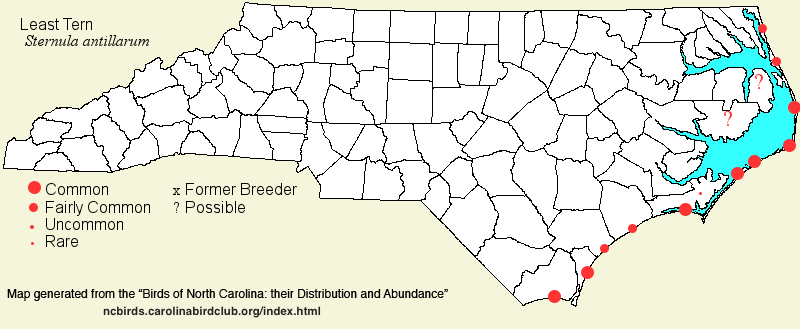 |  |
|
Least Tern - Sternula antillarum LARIDAE Members: | Search Common: Search Scientific: |
|
|
|||||||
| General Comments | The smallest tern in North America, the Least Tern is a familiar yet slowly declining breeding species in coastal areas, as well as along the Mississippi and other large inland rivers. It is no wonder that numbers are declining, as it breeds on bare sand on ocean beaches, island end flats, and on sandy islands, where the nests (of all terns) are susceptible to loss from bad weather, predators, and humans/ATVs. In the past few years there has been an upward trend in breeding numbers in the state, perhaps owing to more vigilant posting and protecting of breeding colonies. In North Carolina, the species forages over the inshore ocean and in sounds/estuaries, rarely at fresh or brackish water. Least Terns are rarely found inland in the state, usually only during or after storms; there are no mountain records. They also depart the state fairly early in fall, with only a few late fall records; there are no documented winter records for the state, though there are a handful of published reports (but probably none documented by photos). | ||||||
| Breeding Status | Breeder | ||||||
| NC BRC List | Definitive | ||||||
| State Status | SC | ||||||
| U.S. Status | |||||||
| State Rank | S3B | ||||||
| Global Rank | G4 | ||||||
| Coastal Plain | Breeding summer resident along the coast; declining until a few years ago, but recently has increased. Generally fairly common to common north to Oregon Inlet, but uncommon to fairly common northward. Somewhat less numerous in the Tidewater zone (around brackish water, mainly). Very rare to rare non-breeder farther inland, where it is mostly a post-breeding visitor or early fall migrant (including some storm-carried records). Along the coast, mainly present from early Apr to mid-Sep; departs early, with very few remaining into Oct; exceptionally from mid-Mar to mid-Nov, but no conclusive winter records (Dec thru Feb). Farther inland, records are mainly from early Jun to early Sep. A handful of birds have been present in the Greenville (Pitt) area in spring and summer 2024-25 and thus might be nesting somewhere there. Peak counts: 2400 adults, at a nesting colony at Lea-Hutaff Island (Pender), spring 2019; 680, Masonboro Inlet (New Hanover), 4 Jul 2015; 320, rooftop nesting area at Emerald Isle, summer 2003. Peak inland count: 54, Lake Waccamaw (Columbus), 4 Aug 2020 (following Hurricane Isaias); 12, Maxton (Robeson), 8 Jul 2024; as many as 12, Greenville (Pitt), summer 2024; 11, Pitt, 20 Apr 2024. | ||||||
| Piedmont | Primarily a storm-carried visitor. Very rare at reservoirs, mainly during and after hurricanes; about 16 records. Eight of these records fall between 19 Aug to 10 Oct, with most records from Hurricane Fran on 6-7 Sep 1996. The only probable non-storm related reports are of two birds at Lake Crabtree (Wake), 15 Jun 2011; one at that lake on 25 May 2015, presumably not carried there by Tropical Storm Ana over two weeks earlier; one at Falls Lake (Durham) on 18 May 2021; one in southern Mecklenburg on 28 May 2021; and one photographed at Oak Hollow Lake (Guilford) on 18 Jun 2023. Singles were noted in 2024 on 16 Jun at Lake Brandt (Guilford) and on 19 June at Blewett Falls Lake (Richmond). Peak counts: 11, Falls Lake, 28 Aug 2011 (after Hurricane Irene); 8, Lake Crabtree, 27 Aug 2011 (after Hurricane Irene); 6, Shelby, 22 Sep 1989 (after Hurricane Hugo); 6 each at Jordan and Falls lakes, 6-7 Sep 1996. | ||||||
| Mountains | No records. | ||||||
| Finding Tips |
This species is not usually missed on coastal birding trips from May through Aug, though it isn't quite a gimme. The birds have clearly declined in North Carolina in the past 30 years, though Leasts are persistent nesters (i.e., will keep trying to nest after storms or other disturbances knock out earlier attempts) and are still relatively numerous in the state. This is one of the few terns that is as easily seen on the southern beaches, such as in Brunswick, as it is along the northern coast. *** | ||||||
| Attribution | LeGrand[2025-07-26], LeGrand[2025-01-30], LeGrand[2024-11-01] | ||||||
| NC Map Map depicts all counties with a report (transient or resident) for the species. | Click on county for list of all known species. |
| NC Breeding Season Map Map depicts assumed breeding season abundance for the species. |  |